Numerical Simulations of Air Flow and Traffic–Related Air Pollution Distribution in a Real Urban Area
Abstract
:1. Introduction
2. Outline of Numerical Simulations
2.1. Urban Model
2.2. Numerical Model
2.3. Meshing and Boundary Conditions
2.4. Pollutant Source Volume (PSV)
3. Ventilation Efficiency and Urban form Indices
3.1. Ventilation Efficiency Indices
3.1.1. Spatially–Averaged Wind Velocity Ratio (VRw)
3.1.2. Spatially–Averaged Normalized Concentration (C*)
3.2. Urban Morphological Parameters
4. Results and Discussion
4.1. CFD Model Validation
4.2. Distributions of Mean Flow Variables
4.3. Effect of Distance from Pollutant Source Volume and Vertical Height on Normalized Pollutant Concentration (C*)
4.4. Vertical Distribution of Air Pollutant Concentration around Typical Buildings
4.5. Effect of Urban Morphological Parameters on Ventilation Efficiency Indices
5. Conclusions
- (1)
- Buildings in urban areas affect wind environments in different aspects such as urban form characteristics, architectural forms, and building heights. Urban ventilation is mainly affected by two flow characteristics: vertically rotating canyon vortices and horizontally rotating corner vortices. Local architectural geometry has a great influence on local ventilation patterns. Furthermore, wind flows near low– to medium–rise buildings indicate complicated wind–building interactions, which may be responsible for the complex air ventilation assessment results in urban areas.
- (2)
- Later, the effect of distance from PSV on C* was investigated. From ground level to a height of 60 m, C* tends to decrease gradually with distance from PSV. C* increases irregularly with an increase in distance between 60 m and 86 m, and two high–value points of C* appear in an area with high–rise buildings. Above 86 m, C* tends to increase linearly with further distance.
- (3)
- In a study of the effect of vertical height on C* it was found that: C* generally decreases with height. Based on the comparison of pollutant contribution rates of two kinds of pollutant sources (ground–level and viaduct–level) at different heights, it is shown that ground sources release 2.9 times more pollutants than viaduct sources at Z–plane = 2.5 m. It was also found that pollutants released by ground–level sources are dominant when the Z–plane is below 8 m high, and pollutants released from viaduct sources are about 0.8–6.1% higher when the Z–plane is above 8 m high.
- (4)
- Quantitative vertical analyses were conducted of C* on the windward and leeward sides of buildings upstream and downstream of the street. Overall, vertical profiles of pollutant concentration were building–specific, and their rates of change were inconsistent with height increases. At the same location, correlations between C* and VRw were different for different PSV. In general, the correlation between C* and VRw and between C* and KEturb was greater for the windward side of the PSV upstream buildings than for the leeward side. Buildings downstream of the PSV showed the opposite situation.
- (5)
- Lastly, the correlation between urban parameter factors and ventilation indices were investigated at the pedestrian level. The 7 urban morphological parameters selected in this study showed no significant correlation with VRw, Cir* and Czs*.
Supplementary Materials
Author Contributions
Funding
Data Availability Statement
Conflicts of Interest
References
- United Nations, Department of Economic and Social Affairs, Population Division. World Urbanization Prospects. 2018. Available online: www.un.org/development/desa/pd/themes/urbanization (accessed on 25 October 2021).
- United Nations. Policies on Spatial Distribution and Urbanization Have Broad Impacts on Sustainable Development. 2020. Available online: https://www.un.org/development/desa/pd/sites/www.un.org.development.desa.pd/files/undes_pd_2020_popfacts_urbanization_policies.pdf (accessed on 26 October 2021).
- Shanghai Municipal Statistics. Shanghai Statistical Yearbook. 2020. Available online: http://tjj.sh.gov.cn/tjnj/20210303/2abf188275224739bd5bce9bf128aca8.html (accessed on 20 April 2021).
- Wang, Y.; Yao, L.; Xu, Y.; Sun, S.; Li, T. Potential heterogeneity in the relationship between urbanization and air pollution, from the perspective of urban agglomeration. J. Clean. Prod. 2021, 298, 126822. [Google Scholar] [CrossRef]
- Ulpiani, G. On the linkage between urban heat island and urban pollution island: Three-decade literature review towards a conceptual framework. Sci. Total Environ. 2021, 751, 141727. [Google Scholar] [CrossRef] [PubMed]
- Sun, D.J.; Shi, X.; Zhang, Y.; Zhang, L. Spatiotemporal distribution of traffic emission based on wind tunnel experiment and computational fluid dynamics (CFD) simulation. J. Clean. Prod. 2020, 282, 124495. [Google Scholar] [CrossRef]
- Vardoulakis, S.; Fisher, B.E.A.; Pericleous, K.; Gonzalez-Flesca, N. Modelling air quality in street canyons: Review. Atmos. Environ. 2003, 37, 155–182. [Google Scholar] [CrossRef] [Green Version]
- Buccolieri, R.; Salim, S.M.; Leo, L.S.; Di Sabatino, S.; Chan, A.; Ielpo, P.; de Gennaro, G.; Gromke, C. Analysis of local scale tree–atmosphere interaction on pollutant concentration in idealized street canyons and application to a real urban junction. Atmos. Environ. 2011, 45, 1702–1713. [Google Scholar] [CrossRef]
- Wang, X.; Yang, X.; Wang, X.; Zhao, J.; Hu, S.; Lu, J. Effect of reversible lanes on the concentration field of road-traffic-generated fine particulate matter (PM2.5). Sustain. Cities Soc. 2020, 62, 102389. [Google Scholar] [CrossRef]
- Xin, Y.L.; Shao, S.Q.; Wang, Z.C.; Xu, Z.W.; Li, H. COVID-2019 Lockdown in Beijing: A Rare Opportunity to Analyze the Contribution Rate of Road Traffic to Air Pollutants. Sustain. Cities Soc. 2021, 75, 102989. [Google Scholar] [CrossRef]
- Yuan, M.; Song, Y.; Huang, Y.; Shen, H.; Li, T. Exploring the association between the built environment and remotely sensed PM2.5 concentrations in urban areas. J. Clean Prod. 2019, 220, 1014–1023. [Google Scholar] [CrossRef]
- Chang, D.; Song, Y.; Liu, B. Visibility trends in six megacities in China 1973–2007. Atmos. Res. 2009, 94, 161–167. [Google Scholar] [CrossRef]
- Quan, J.; Zhang, Q.; He, H.; Liu, J.; Huang, M.; Jin, H. Analysis of the formation of fog and haze in North China Plain (NCP). Atmos. Chem. Phys. 2011, 11, 8205–8214. [Google Scholar] [CrossRef] [Green Version]
- Wu, J.; Fu, C.B.; Zhang, L.Y.; Tang, J.P. Trends of visibility on sunny days in China in the recent 50 years. Atmos. Environ. 2012, 55, 339–346. [Google Scholar] [CrossRef]
- Edussuriya, P.; Chan, A.; Ye, A. Urban morphology and air quality in dense residential environments in Hong Kong. Part I: District-level analysis. Atmos. Environ. 2011, 45, 4789–4803. [Google Scholar] [CrossRef]
- Santiago, J.L.; Martin, F. Use of CFD modeling for estimating spatial representativeness of urban air pollution monitoring sites and suitability of their locations. Física Dela Tierra 2015, 27, 191. [Google Scholar]
- Deng, X.; Li, F.; Li, Y.; Li, J.; Huang, H.; Liu, X. Vertical distribution characteristics of PM in the surface layerof Guangzhou. Particuology 2014, 20, 3–9. [Google Scholar] [CrossRef]
- Han, S.; Bian, H.; Tie, X.; Xie, Y.; Sun, M.; Liu, A. Impact of nocturnal planetary boundary layer on urban air pollutants: Measurements from a 250-m tower over Tianjin, China. J. Hazard. Mater. 2009, 162, 264–269. [Google Scholar] [CrossRef] [PubMed]
- Sun, Y.; Wang, Y.; Zhang, C. Measurement of the vertical profile of atmospheric SO2 during the heating period in Beijing on days of high air pollution. Atmos. Environ. 2009, 43, 468–472. [Google Scholar]
- Fan, S.H.; Gao, C.Y.; Yang, Y.J.; Liu, Z.; Hu, B.; Wang, Y.; Wang, J.; Gao, Z. Elucidating roles of near-surface vertical layer structure in different stages of PM2.5 pollution episodes over urban Beijing during 2004–2016. Atmos. Environ. 2020, 246, 118157. [Google Scholar] [CrossRef]
- Peng, Z.R.; Wang, D.S.; Wang, Z.Y.; Gao, Y.; Lu, S.J. A study of vertical distribution patterns of PM2.5 concentrations based on ambient monitoring with unmanned aerial vehicles: A case in Hangzhou, China. Atmos. Environ. 2015, 123, 357–369. [Google Scholar] [CrossRef]
- Li, X.; Leung, D.Y.C.; Liu, C.H.; Lam, K.M. Physical modeling of flow field inside urban street canyons. J. Appl. Meteorol. Climatol. 2008, 47, 2058–2067. [Google Scholar] [CrossRef]
- Yassin, M.F. A wind tunnel study on the effect of thermal stability on flow and dispersion of rooftop stack emissions in the near wake of a building. Atmos. Environ. 2013, 65, 89–100. [Google Scholar] [CrossRef]
- Gromke, C. A vegetation modeling concept for building and environmental aerodynamics wind tunnel tests and its application in pollutant dispersion studies. Environ. Pollut. 2011, 159, 2094–2099. [Google Scholar] [CrossRef] [PubMed]
- Murakami, S.; Mochida, A.; Sakamoto, S. Numerical study on velocity-pressure field and wind forces for bluff bodies by κ-ϵ, ASM and LES. J. Wind Eng. Ind. Aerod. 1992, 44, 2841–2852. [Google Scholar] [CrossRef]
- Tominaga, Y.; Mochida, A.; Yoshie, R.; Kataoka, H.; Nozu, T.; Yoshikawa, M.; Shirasawa, T. AIJ guidelines for practical applications of CFD to pedestrian wind environment around buildings. J. Wind Eng. Ind. Aerod. 2008, 96, 1749–1761. [Google Scholar] [CrossRef]
- Blocken, B.; Carmeliet, J.; Stathopoulos, T. CFD evaluation of wind speed conditions in passages between parallel buildings-effect of wall-function roughness modifications for the atmospheric boundary layer flow. J. Wind Eng. Ind. Aerodyn. 2007, 95, 941–962. [Google Scholar] [CrossRef]
- Blocken, B. 50 years of computational wind engineering: Past, present and future. J. Wind Eng. Ind. Aerodyn. 2014, 129, 69–102. [Google Scholar] [CrossRef]
- Tamura, Y.; Xu, X.D.; Yang, Q.S. Characteristics of pedestrian-level Mean wind speed around square buildings: Effects of height, width, size and approaching flow profile. J. Wind Eng. Ind. Aerodyn. 2019, 192, 74–87. [Google Scholar] [CrossRef]
- Xie, X.M.; Liu, C.H.; Leung, D.Y.C. Impact of building facades and ground heating on wind flow and pollutant transport in street canyons. Atmos. Environ. 2007, 41, 9030–9049. [Google Scholar] [CrossRef]
- Xie, X.M.; Huang, Z.; Wang, J.S. Impact of building configuration on air quality in street canyon. Atmos. Environ. 2005, 39, 4519–4530. [Google Scholar] [CrossRef]
- Cheng, W.C.; Liu, C.H.; Leung, D.Y.C. On the correlation of air and pollutant exchange for street canyons in combined wind-buoyancy-driven flow. Atmos. Environ. 2009, 43, 3682–3690. [Google Scholar] [CrossRef]
- Liu, C.H.; Wong, C.C.C. On the pollutant removal, dispersion, and entrainment over two-dimensional idealized street canyons. Atmos. Res. 2014, 135, 128–142. [Google Scholar] [CrossRef] [Green Version]
- Mei, S.H.; Luo, Z.W.; Zhao, F.Y.; Wang, H.Q. Street canyon ventilation and airborne pollutant dispersion: 2-D versus 3-D CFD simulations. Sustain. Cities Soc. 2019, 50, 101700. [Google Scholar] [CrossRef]
- Hang, J.; Luo, Z.; Wang, X.; He, L.; Wang, B.; Zhu, W. The influence of street layouts and viaduct settings on daily carbon monoxide exposure and intake fraction in idealized urban canyons. Environ. Pollut. 2016, 220, 72–86. [Google Scholar] [CrossRef] [PubMed]
- da Silva, F.T.; Reis, N.C., Jr.; Santos, J.M.; Goulart, E.V.; de Alvarez, C.E. The impact of urban block typology on pollutant dispersion. J. Wind Eng. Ind. Aerod. 2021, 210, 104524. [Google Scholar] [CrossRef]
- Mei, S.J.; Hu, J.T.; Liu, D.; Zhao, F.Y.; Li, Y.; Wang, Y.; Wang, H.Q. Wind driven natural ventilation in the idealized building block arrays with multiple urban morphologies and unique package building density. Build. Environ. 2017, 92, 152–166. [Google Scholar] [CrossRef]
- Hu, T.; Yoshie, R. Indices to evaluate ventilation efficiency in newly-built urban area at pedestrian level. J. Wind Eng. Ind. Aerod. 2013, 112, 39–51. [Google Scholar] [CrossRef]
- Hang, J.; Sandberg, M.; Li, Y.G. Pollutant dispersion in idealized city models with different urban morphologies. Atmos. Environ. 2009, 43, 6011–6025. [Google Scholar] [CrossRef]
- Di Sabatino, S.; Buccolieri, R.; Pulvirenti, B.; Britter, R. Simulations of pollutant dispersion within idealised urban-type geometries with CFD and integral models. Atmos. Environ. 2007, 41, 8316–8329. [Google Scholar] [CrossRef]
- Hang, J. Wind Conditions and City Ventilation in Idealized City Models. Ph.D. Thesis, The University of Hong Kong, Hong Kong, China, 2009. [Google Scholar]
- Jiang, Z.W.; Cheng, H.M.; Zhang, P.H.; Kang, T.F. Influence of urban morphological parameters on the distribution and diffusion of air pollutants: A case study in China. J. Environ. Sci. 2021, 105, 163–172. [Google Scholar] [CrossRef]
- Hang, J.; Li, Y.G.; Buccolieri, R.; Sabatino, S.D. The influence of building height variability on pollutant dispersion and pedestrian ventilation in idealized high-rise urban areas. Build. Environ. 2012, 56, 346–360. [Google Scholar] [CrossRef]
- Zhang, C.F.; Wen, M.; Zeng, J.R.; Zhang, G.L.; Fang, H.P.; Li, Y. Modeling theimpact of the viaduct on particles dispersion from vehicle exhaust in street canyons. Sci. China Technol. Sci. 2012, 55, 48–55. [Google Scholar] [CrossRef]
- Hang, J.; Xian, Z.; Wang, D.; Mak, C.M.; Wang, B.; Fan, Y. The impacts of viaduct settings and street aspect ratios on personal intake fraction in three-dimensional urban-like geometries. Build. Environ. 2018, 143, 138–162. [Google Scholar] [CrossRef]
- Michioka, T.; Takimoto, H.; Sato, A. Large-eddy simulation of pollutant removal from a three-dimensional street canyon. Bound. Layer Meteorol. 2014, 150, 259–275. [Google Scholar] [CrossRef]
- Assimakopoulos, V.D.; ApSimon, H.M.; Moussiopoulos, N. A numerical study of atmospheric pollutant dispersion in different two-dimensional street canyon configurations. Atmos. Environ. 2003, 37, 4037–4049. [Google Scholar] [CrossRef]
- Huang, Y.D.; Hu, X.N.; Zeng, N.B. Impact of wedge-shaped roofs on airflow and pollutant dispersion inside urban street canyons. Build. Environ. 2009, 44, 2335–2347. [Google Scholar] [CrossRef]
- Baik, J.J.; Kim, J.J. A numerical study of flow and pollutant dispersion characteristics in urban street canyons. J. Appl. Meteorol. 1999, 38, 1576–1589. [Google Scholar] [CrossRef]
- Xie, X.; Huang, Z.; Wang, J. The impact of urban street layout on local atmospheric environment. Build. Environ. 2006, 41, 1352–1363. [Google Scholar]
- Garmory, P.A.; Ketzel, M.; Berkowicz, R.; Britter, R. Comparative study of measured and modelled number concentrations of nanoparticles in an urban street canyon. Atmos. Environ. 2009, 43, 949–958. [Google Scholar]
- Jiang, G.Y.; Hu, T.T.; Yang, H.K. Effects of Ground Heating on Ventilation and Pollutant Transport in Three-Dimensional Urban Street Canyons with Unit Aspect Ratio. Atmosphere 2019, 10, 286. [Google Scholar] [CrossRef] [Green Version]
- Li, Y.; Stathopoulos, T. Numerical evaluation of wind-induced dispersion of pollutants around a building. J. Wind Eng. Ind. Aerodyn. 1997, 67–68, 757–766. [Google Scholar] [CrossRef]
- Peric, M.; Ferguson, S. The advantage of polyhedral meshes. Dynamics 2005, 24, 45. [Google Scholar]
- Franke, J.; Hellsten, A.; Schlünzen, H.; Carissimo, B. Best Practice Guideline for the CFD Simulation of Flows in the Urban Environments. Tech. Rep. COST Action 2007, 732. [Google Scholar]
- Ma, T.; Duan, F.; He, K.; Qin, Y.; Tong, D.; Geng, G.; Liu, X.; Li, H.; Yang, S.; Ye, S.; et al. Air pollution characteristics and their relationship with emissions and meteorology in the Yangtze River Delta region during 2014–2016. J. Environ. Sci. 2019, 83, 8–20. [Google Scholar] [CrossRef] [PubMed]
- Ng, E. Air ventilation assessment for high density city-an experience from Hongkong. In Proceedings of the Seventh International Conference on Urban Climate, Yokohama, Japan, 29 June–3 July 2009. [Google Scholar]
- Huang, H.; Ooka, R.; Kato, S.; Jiang, T. CFD analysis of ventilation efficiency around an elevated highway using visitation frequency and purging flow rate. Wind. Struct. 2006, 9, 297–313. [Google Scholar] [CrossRef]
- Santiago, J.L.; Coceal, O.; Martilli, A.; Belcher, S.E. Variation of the Sectional Drag Coefficient of a Group of Buildings with Packing Density. Build. Vent. Theory Meas. 2008, 128, 445–457. [Google Scholar] [CrossRef]
- Kanda, M. Large-eddy simulations on the effects of surface geometry of building arrays on turbulent organized structures. Bound.-Layer Meteorol. 2006, 118, 151–168. [Google Scholar] [CrossRef]
- Hang, J.; Wang, Q.; Chen, X.; Sandberg, M.; Zhu, W.; Buccolieri, R.; Di Sabatino, S. City breathability in medium density urban-like geometries evaluated through the pollutant transport rate and the net escape velocity. Build. Environ. 2015, 94, 166–182. [Google Scholar] [CrossRef]
- Hu, T.T.; Yoshie, R. Effect of atmospheric stability on air pollutant concentration and its generalization for real and idealized urban block models based on field observation data and wind tunnel experiments. J. Wind Eng. Ind. Aerod. 2020, 207, 104380. [Google Scholar] [CrossRef]
- Zhang, S.W.; Kwok, K.C.S.; Liu, H.H.; Jiang, Y.C.; Dong, K.J.; Wang, B. A CFD study of wind assessment in urban topology with complex wind flow. Sustain. Cities Soc. 2021, 71, 103006. [Google Scholar] [CrossRef]
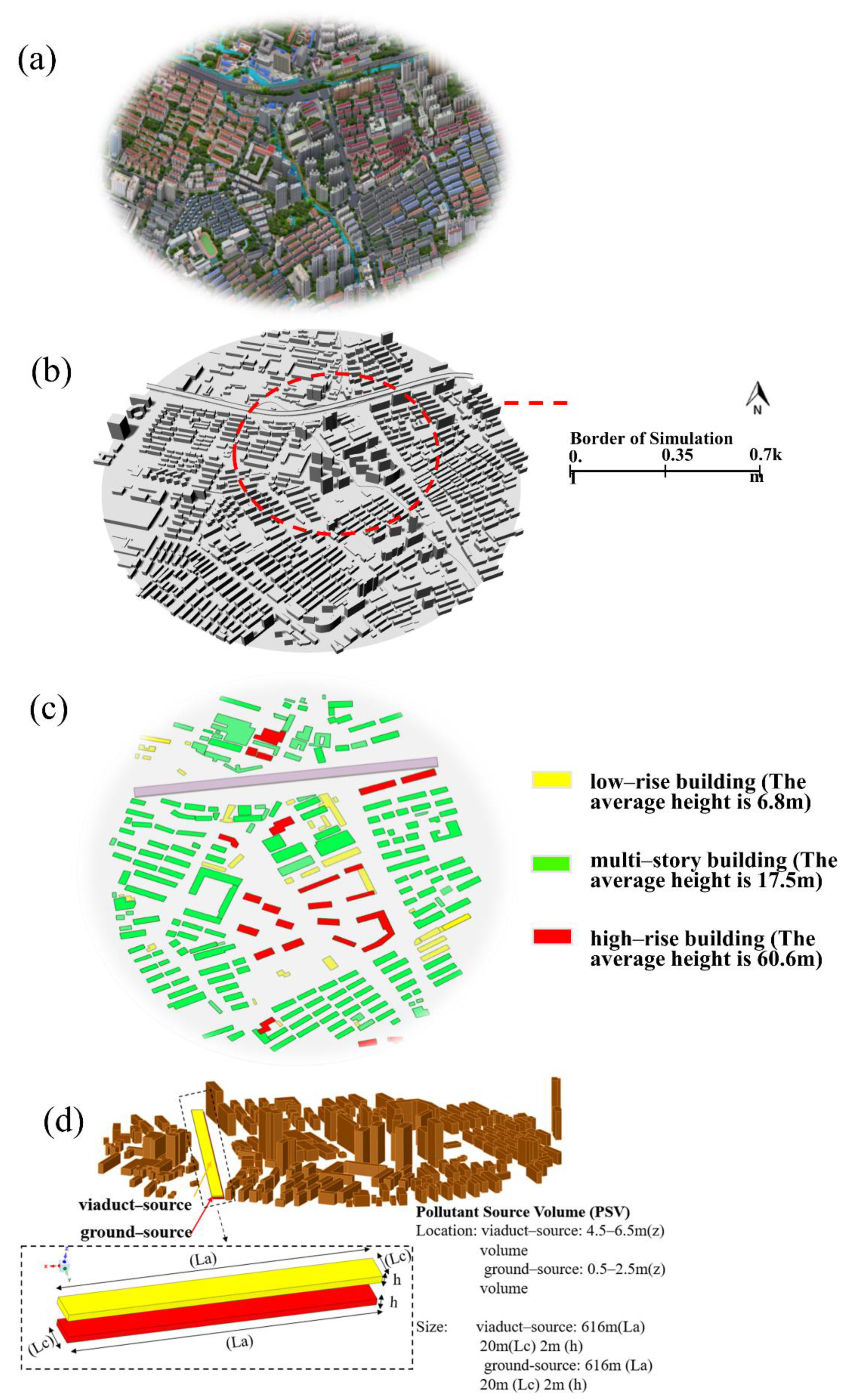
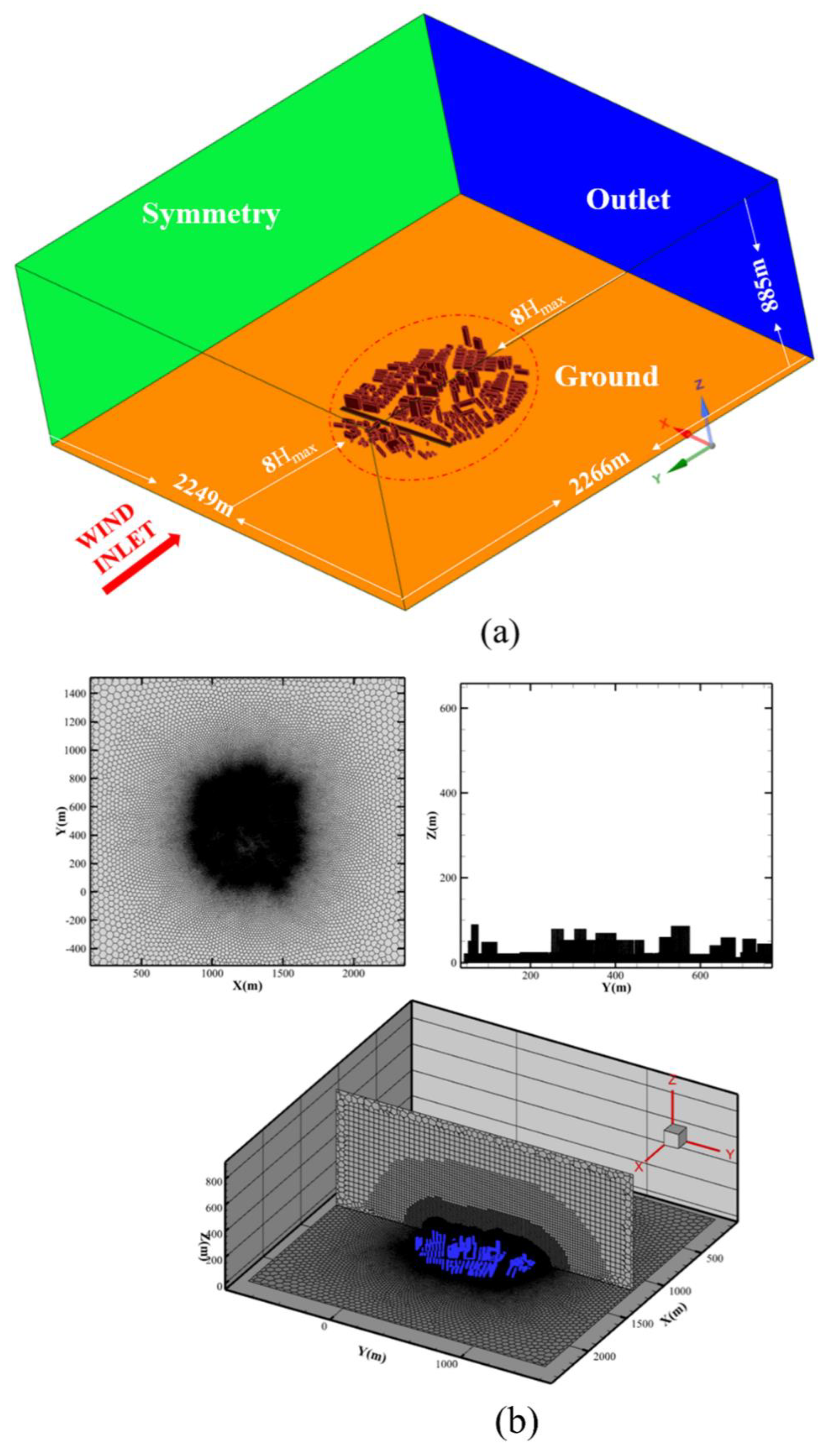

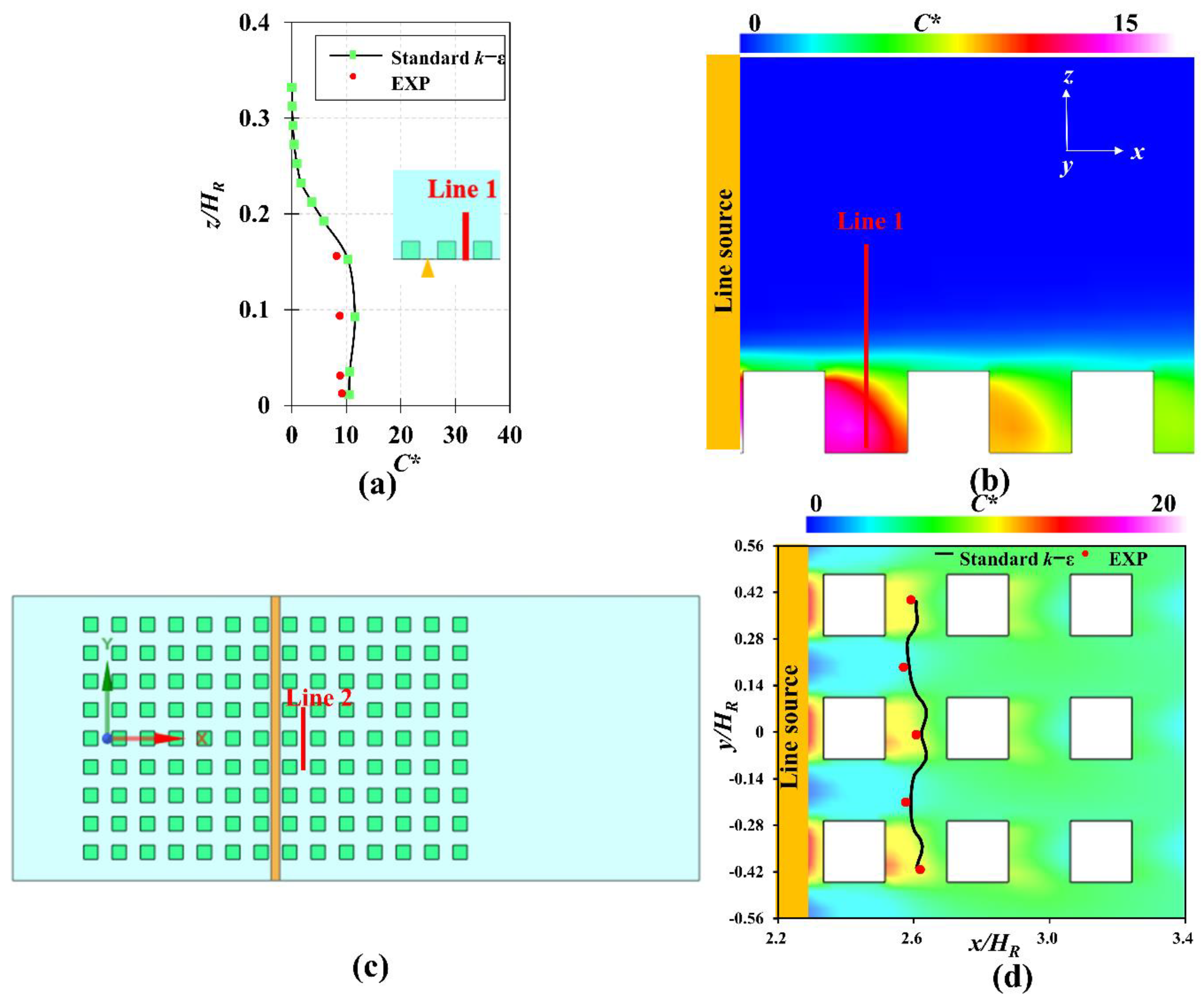
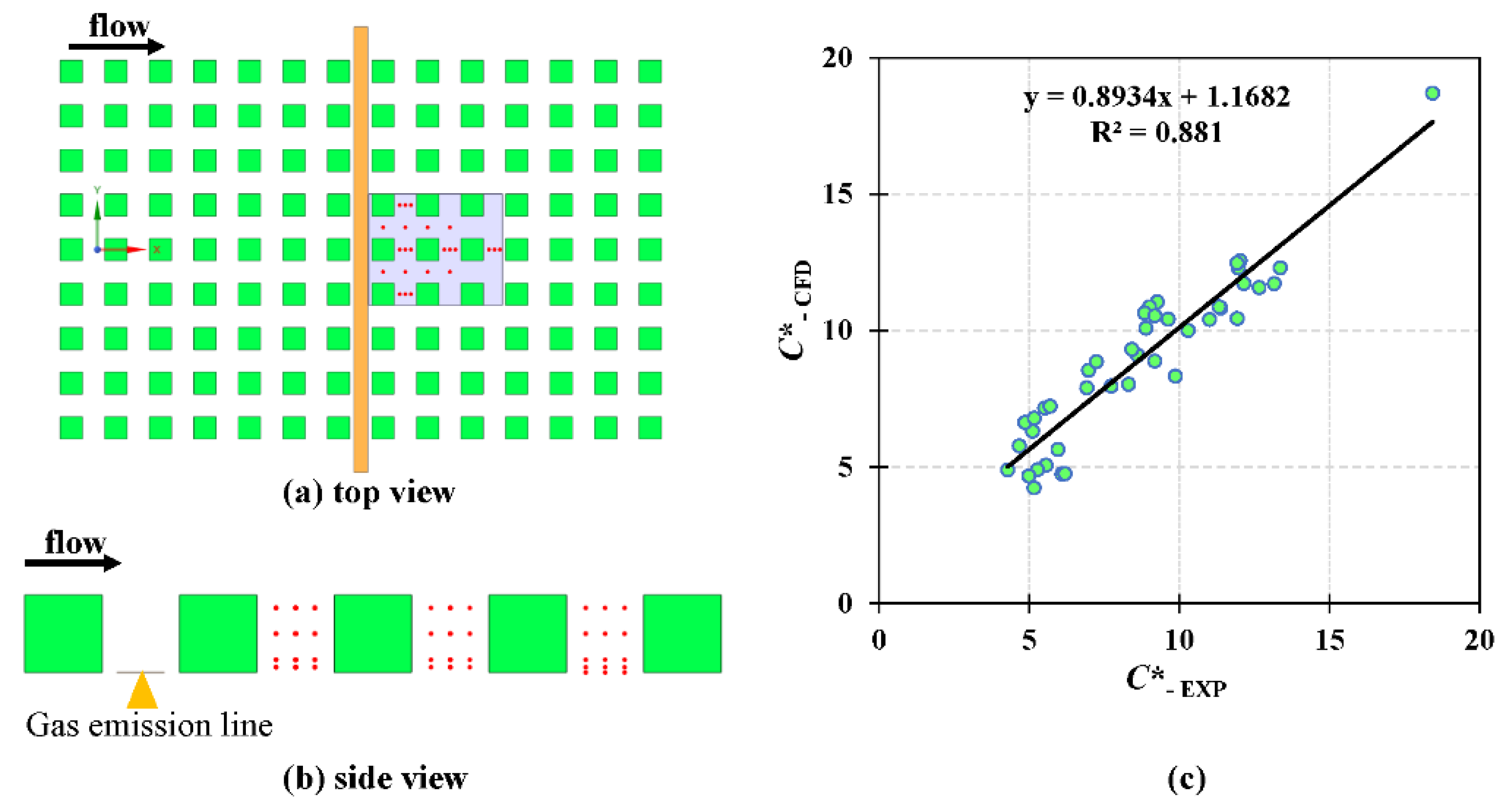

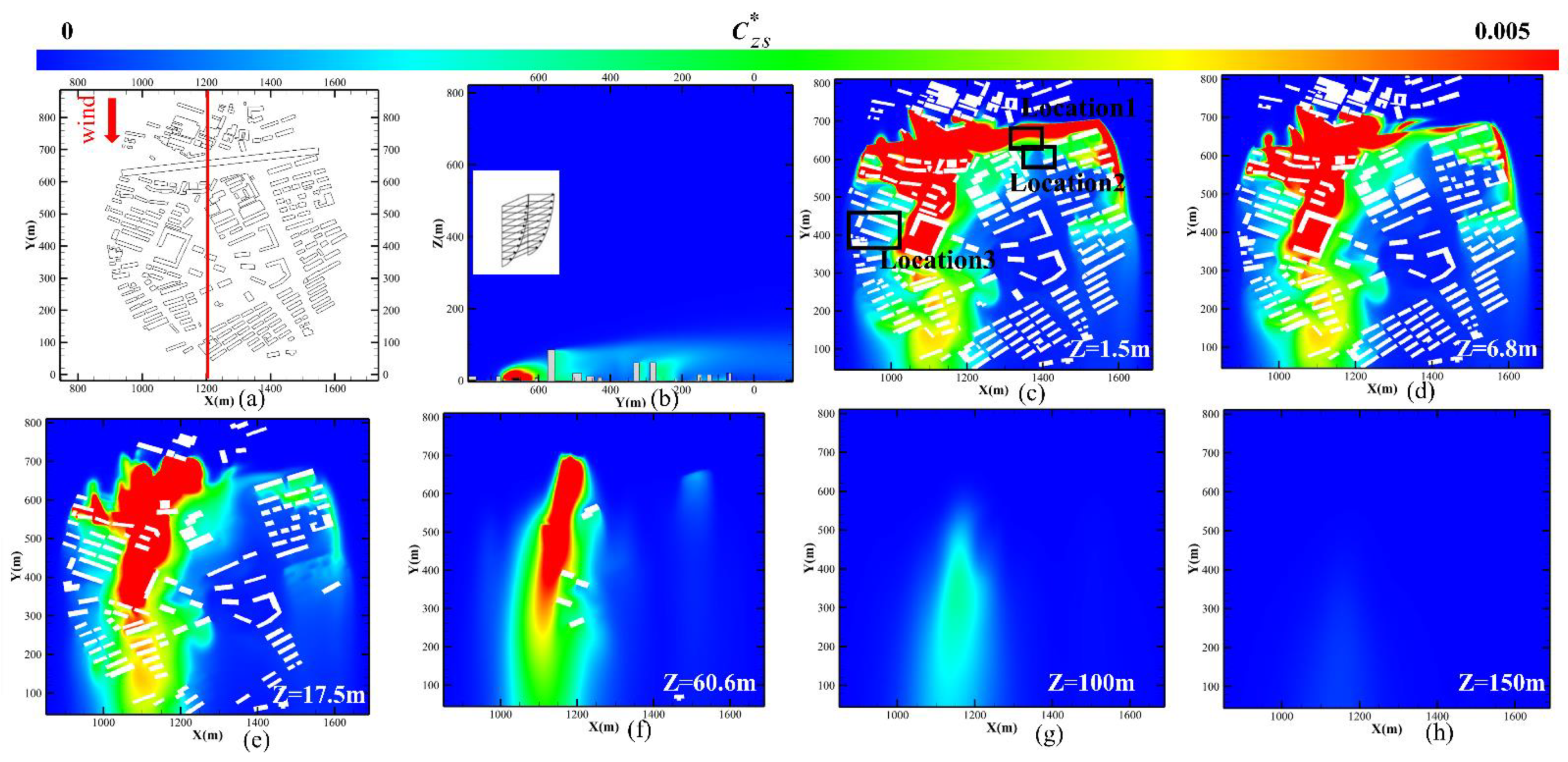

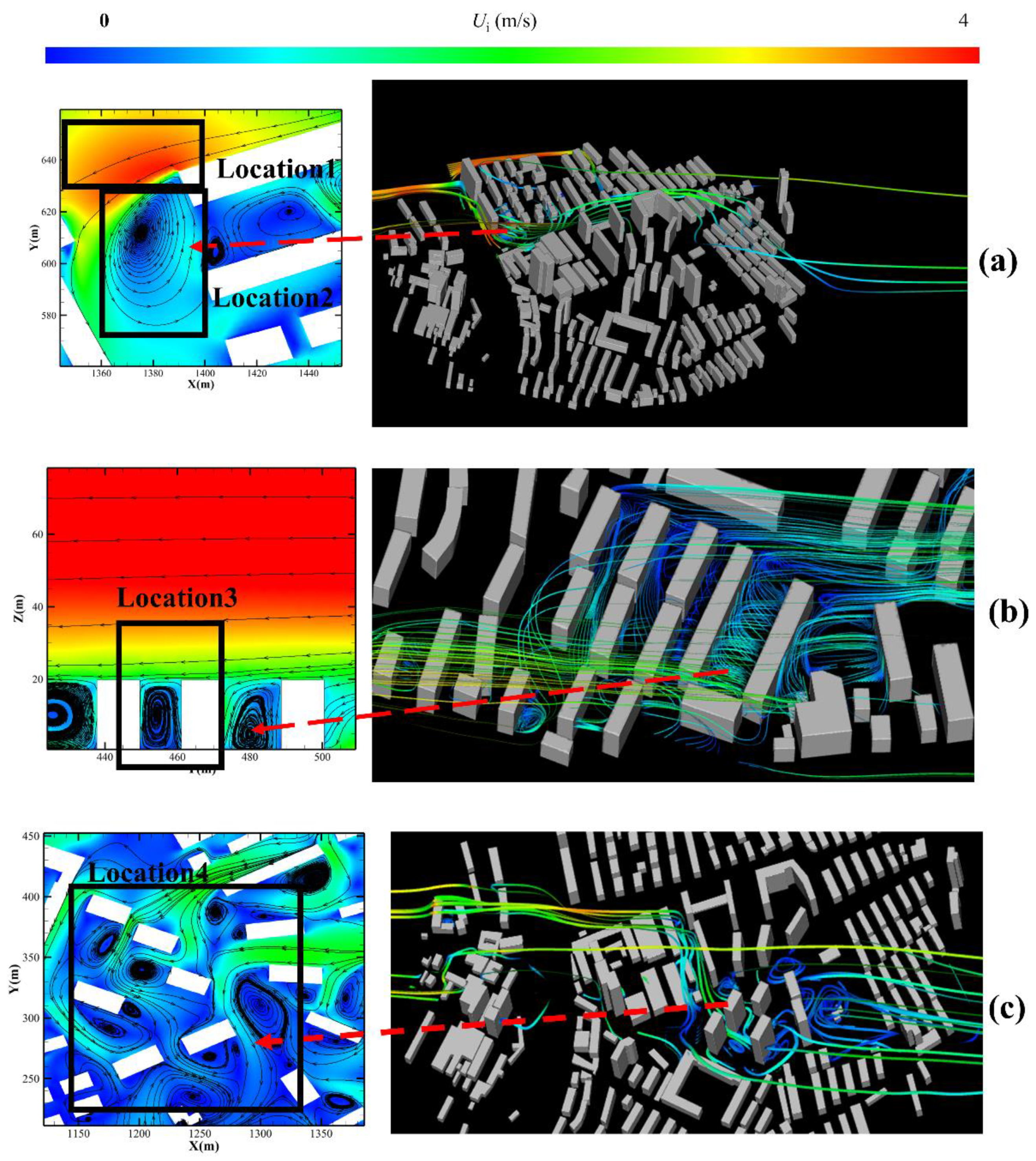
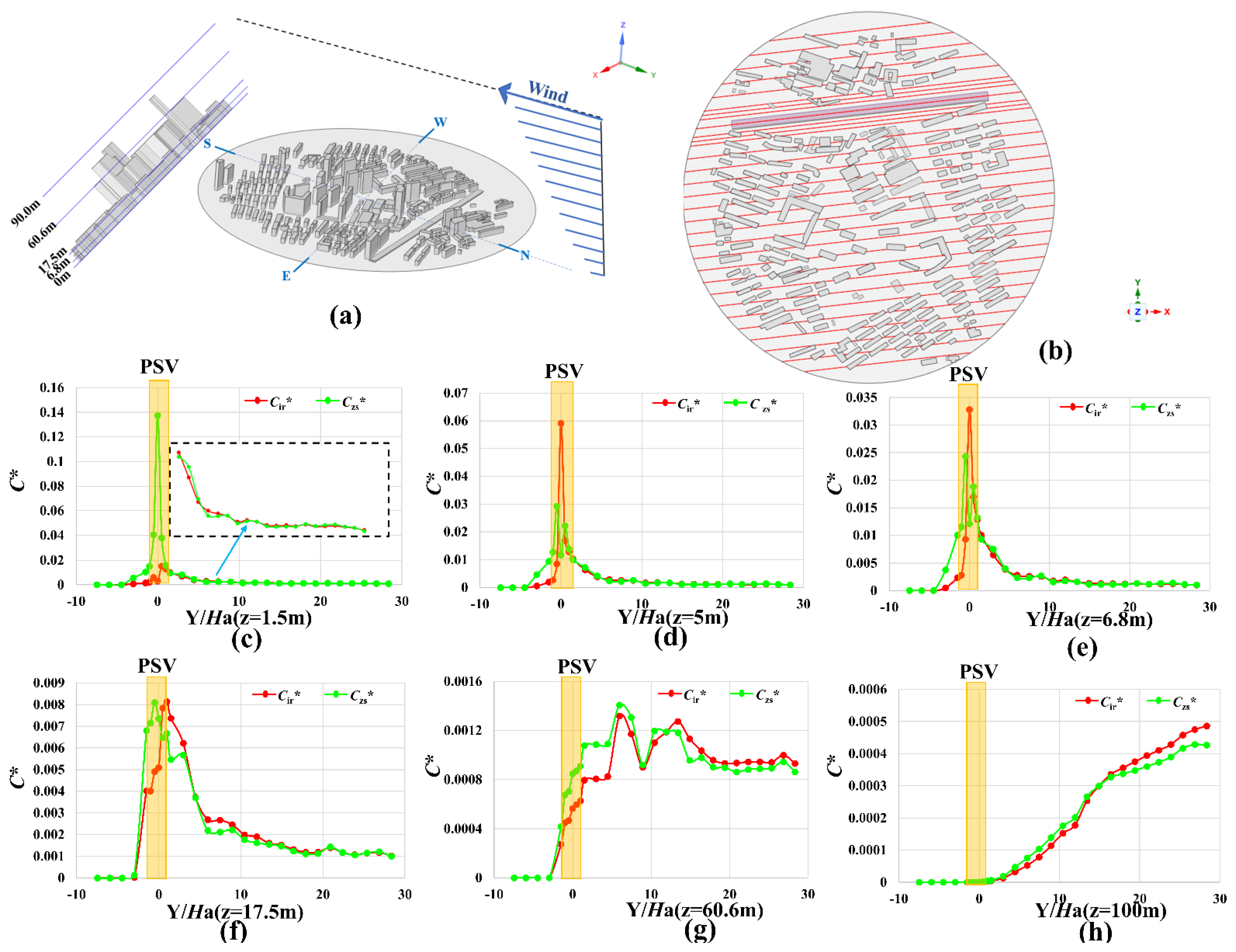
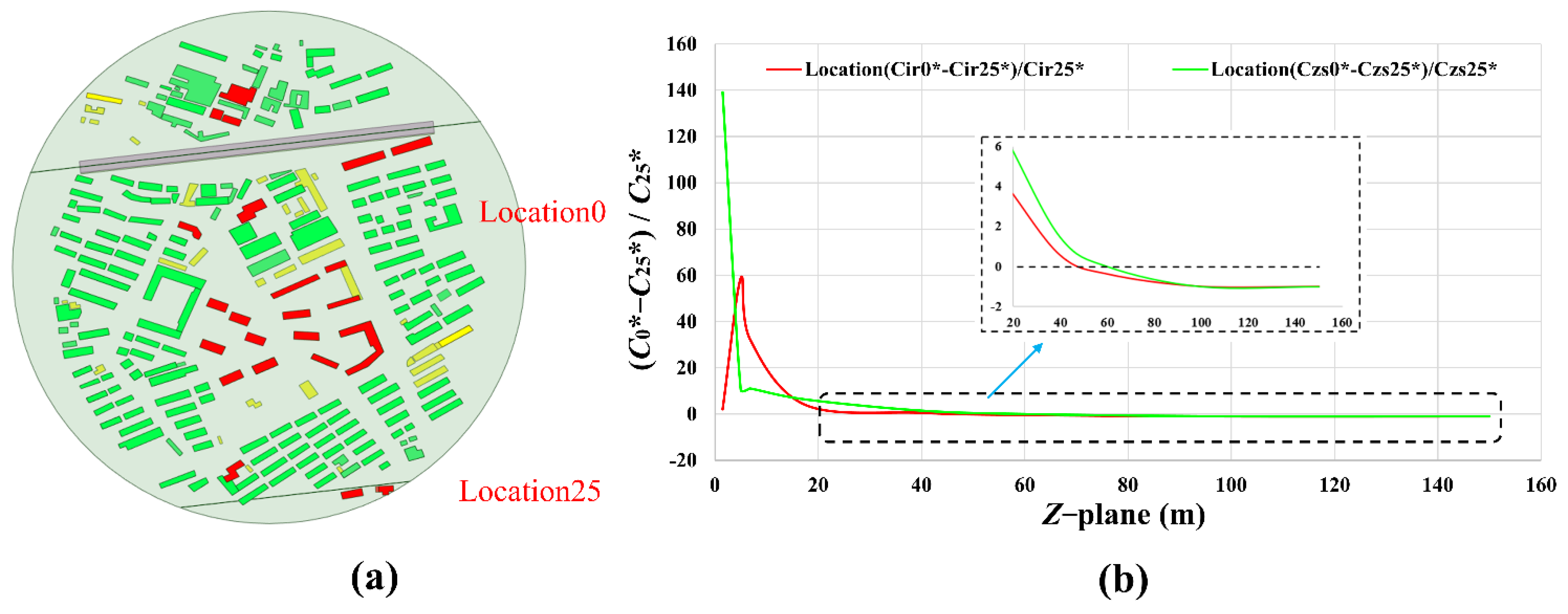

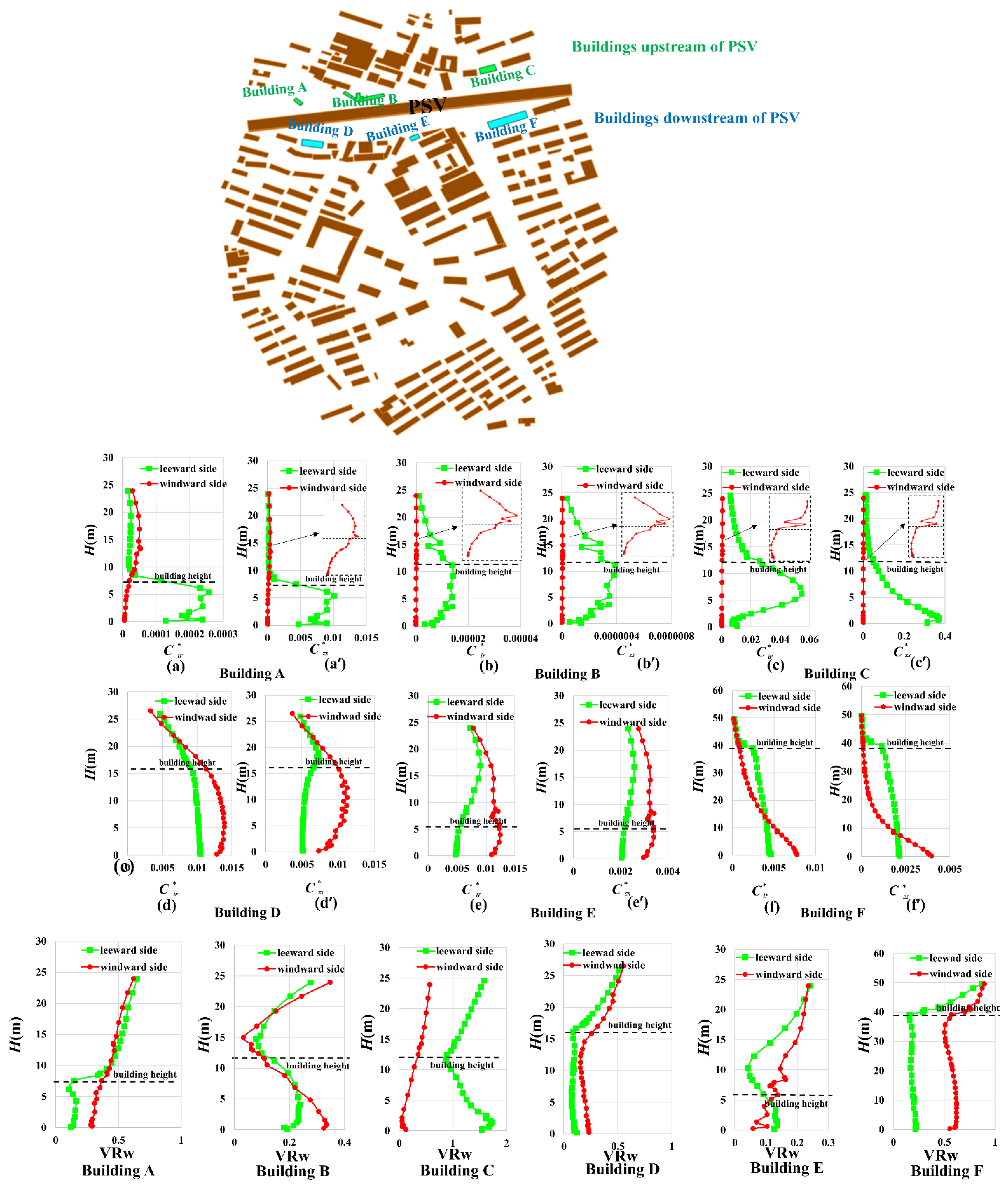
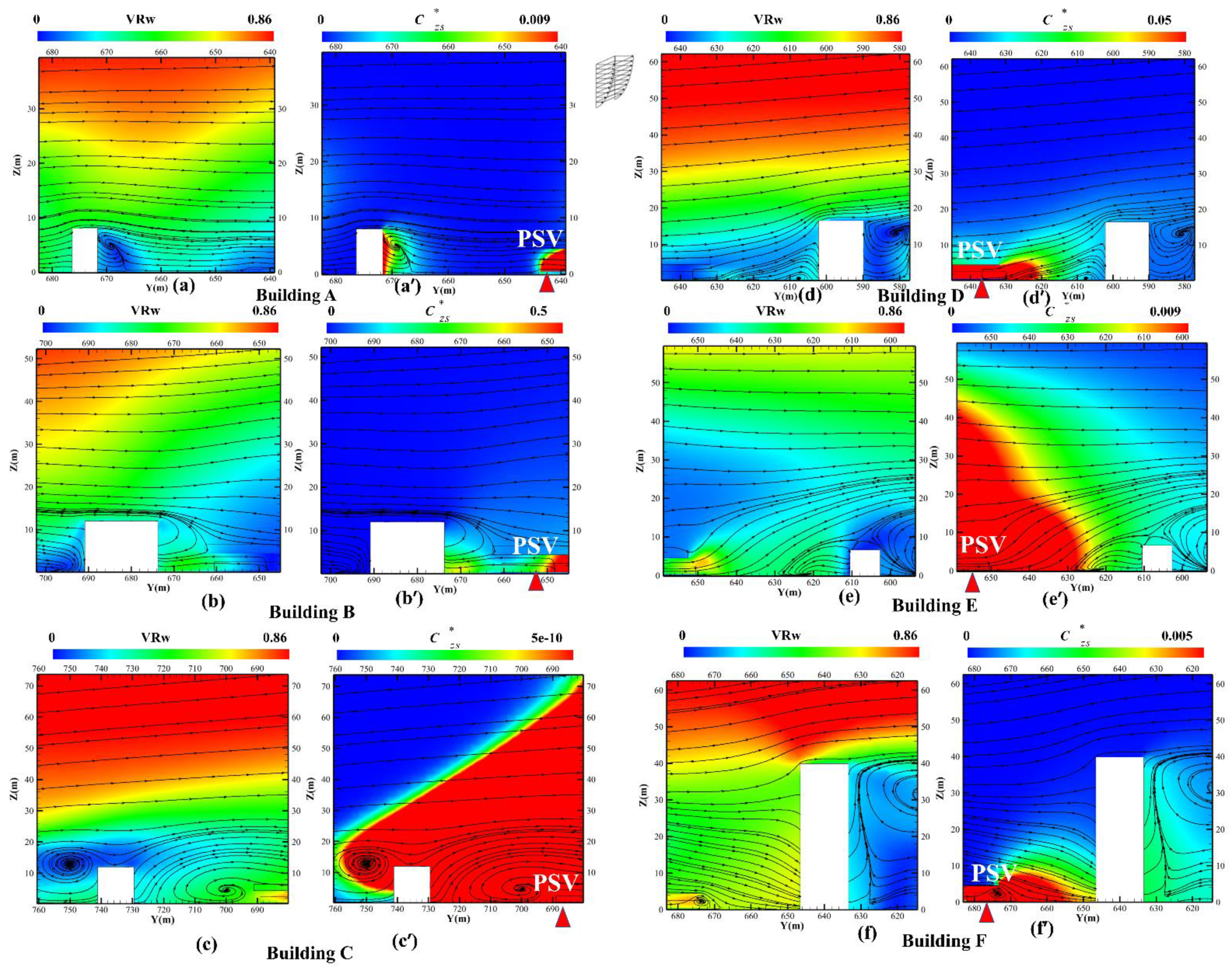
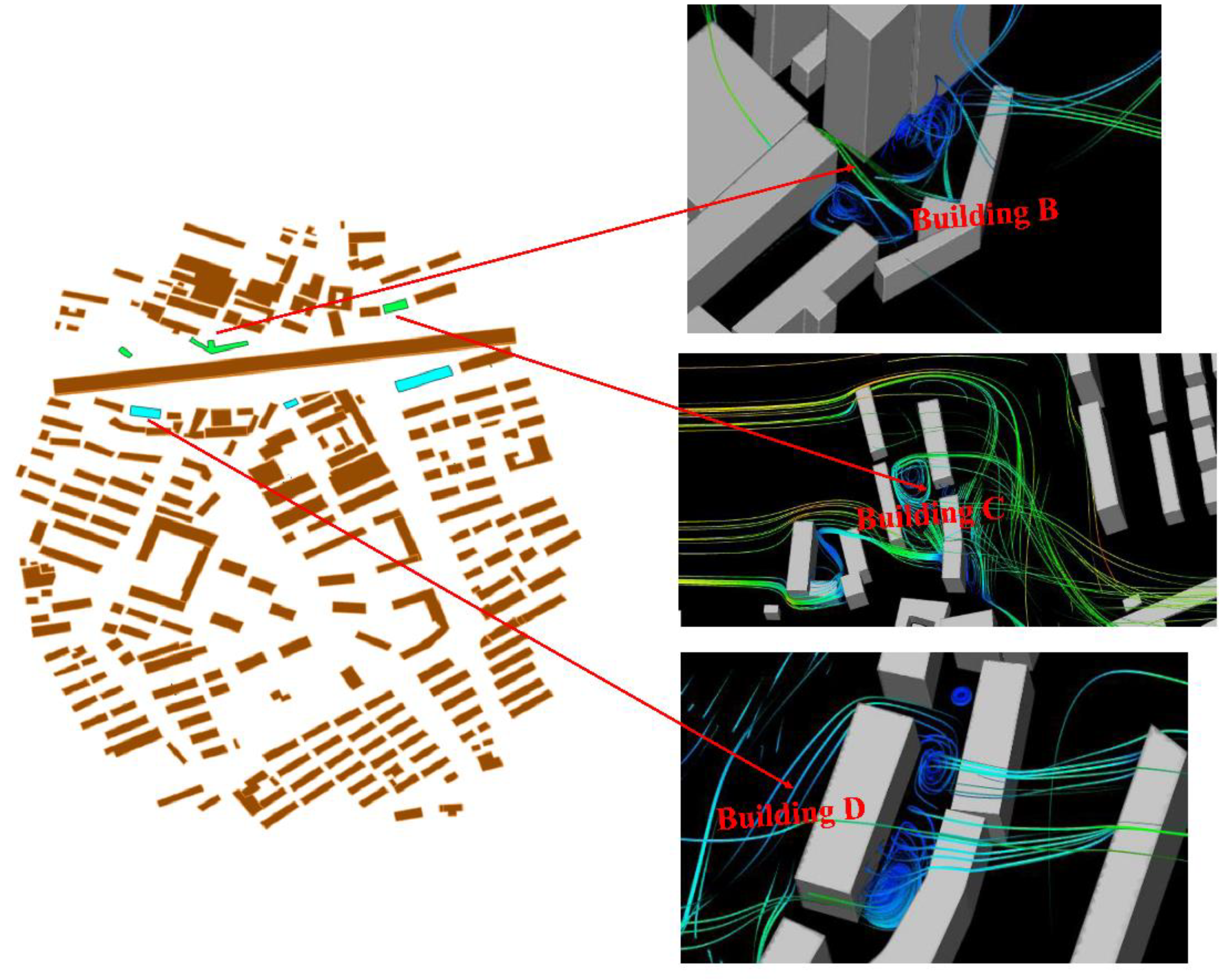

| Code | Fluent 2020 R2 |
|---|---|
| Tubulence | Standard – model |
| Inlet | u = Uref (z/zref) α, α = 0.27, zref = 79 m, Uref = 4.64 m/s = (I(z)u(z))2, I(z) = 0.1(z/zG)−α−0.05, zG = 550 m , Cu = 0.09 |
| Outlet | Outflow |
| Upper and side surface | Symmetry |
| Building surface and ground | Wall function |
| Overall Summary (grid) | 6,734,290 |
| r/R2 | Leeward | Windward | |||
|---|---|---|---|---|---|
| Buildings | Cir* | Czs* | Cir* | Czs* | |
| A | VRw | −0.793/0.629 | −0.796/0.634 | 0.992/0.984 | 0.992/0.984 |
| B | VRw | −0.700/0.490 | 0.992/0.984 | 0.864/0.746 | 0.862/0.743 |
| C | VRw | 0.097/0.009 | −0.084/0.007 | −0.981/0.963 | −0.981/0.962 |
| D | VRw | −0.145/0.021 | 0.278/0.078 | −0.546/0.298 | −0.677/0.458 |
| E | VRw | −0.964/0.929 | −0.962/0.925 | 0.618/0.382 | 0.754/0.568 |
| F | VRw | 0.866/0.751 | 0.839/0.704 | 0.754/0.568 | 0.633/0.401 |
| r/R2 | Leeward | Windward | |||
|---|---|---|---|---|---|
| Buildings | Cir* | Czs* | Cir* | Czs* | |
| A | KEturb | −0.690/0.476 | −0.670/0.449 | −0.866/0.751 | −0.866/0.751 |
| B | KEturb | 0.531/0.282 | −0.941/0.886 | 0.051/0.003 | 0.051/0.003 |
| C | KEturb | 0.563/0.465 | 0.682/0.317 | 0.923/0.857 | 0.926/0.857 |
| D | KEturb | −0.949/0.901 | 0.983/0.881 | −0.757/0.574 | 0.597/0.356 |
| E | KEturb | 0.803/0.645 | 0.813/0.660 | 0.800/0.629 | 0.920/0.847 |
| F | KEturb | −0.967/0.822 | −0.900/0.802 | −0.842/0.709 | −0.751/0.564 |
| Test Parameters | R | R2 | Adjusted R2 | F Ratio | p-Value | |
|---|---|---|---|---|---|---|
| BD | VRw | 0.251 | 0.023 | 0.029 | 1.822 | 0.188 |
| Cir* | 0.066 | 0.004 | −0.032 | 0.119 | 0.194 | |
| Czs* | 0.064 | 0.004 | −0.033 | 0.111 | 0.742 | |
| FAR | VRw | 0.210 | 0.044 | 0.009 | 1.245 | 0.274 |
| Cir* | 0.116 | 0.013 | −0.023 | 0.365 | 0.551 | |
| Czs* | 0.266 | 0.071 | 0.037 | 2.063 | 0.162 | |
| SO | VRw | 0.020 | 0.0003 | −0.037 | 0.011 | 0.918 |
| Cir* | 0.072 | 0.005 | −0.032 | 0.139 | 0.712 | |
| Czs* | 0.002 | 3.083 × 10−6 | −0.037 | 8.325 × 10−5 | 0.993 | |
| AH | VRw | 0.056 | 0.003 | −0.034 | 0.085 | 0.773 |
| Cir* | 0.165 | 0.027 | −0.009 | 0.753 | 0.393 | |
| Czs* | 0.201 | 0.040 | 0.005 | 1.134 | 0.296 | |
| SDH | VRw | 0.127 | 0.016 | −0.020 | 0.443 | 0.511 |
| Cir* | 0.071 | 0.005 | −0.032 | 0.137 | 0.714 | |
| Czs* | 0.170 | 0.029 | −0.007 | 0.799 | 0.379 | |
| MBV | VRw | 0.108 | 0.012 | −0.025 | 0.321 | 0.576 |
| Cir* | 0.149 | 0.022 | −0.014 | 0.611 | 0.441 | |
| Czs* | 0.216 | 0.047 | 0.011 | 1.322 | 0.260 | |
| DE | VRw | 0.059 | 0.004 | −0.033 | 0.095 | 0.760 |
| Cir* | 0.112 | 0.013 | −0.024 | 0.344 | 0.563 | |
| Czs* | 0.168 | 0.028 | −0.008 | 0.781 | 0.385 | |
Publisher’s Note: MDPI stays neutral with regard to jurisdictional claims in published maps and institutional affiliations. |
© 2022 by the authors. Licensee MDPI, Basel, Switzerland. This article is an open access article distributed under the terms and conditions of the Creative Commons Attribution (CC BY) license (https://creativecommons.org/licenses/by/4.0/).
Share and Cite
Zhou, M.; Hu, T.; Jiang, G.; Zhang, W.; Wang, D.; Rao, P. Numerical Simulations of Air Flow and Traffic–Related Air Pollution Distribution in a Real Urban Area. Energies 2022, 15, 840. https://doi.org/10.3390/en15030840
Zhou M, Hu T, Jiang G, Zhang W, Wang D, Rao P. Numerical Simulations of Air Flow and Traffic–Related Air Pollution Distribution in a Real Urban Area. Energies. 2022; 15(3):840. https://doi.org/10.3390/en15030840
Chicago/Turabian StyleZhou, Mengge, Tingting Hu, Guoyi Jiang, Wenqi Zhang, Dan Wang, and Pinhua Rao. 2022. "Numerical Simulations of Air Flow and Traffic–Related Air Pollution Distribution in a Real Urban Area" Energies 15, no. 3: 840. https://doi.org/10.3390/en15030840
APA StyleZhou, M., Hu, T., Jiang, G., Zhang, W., Wang, D., & Rao, P. (2022). Numerical Simulations of Air Flow and Traffic–Related Air Pollution Distribution in a Real Urban Area. Energies, 15(3), 840. https://doi.org/10.3390/en15030840






